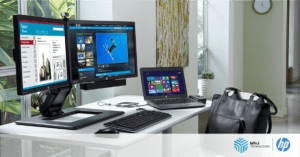Many businesses have suddenly found themselves in the deep end of the pool with remote working and virtual meetings. While some are quite comfortable with virtual meetings having worked from home for some time, many are experiencing challenges with adopting the technology in a way that keeps their team productive. From managing the discomfort of being on video from home to keeping teams engaged, here are some of the top tips for running productive meetings.
1. Scheduling time
You know the scenario: everyone has agreed to a meeting at a certain time, and then someone says they can’t make it, can the meeting be moved, and suddenly the whole calendar is up for debate again. The more people on your team, the more challenging it becomes to accommodate everyone’s schedule. If you’re managing a team, the best practice is to set a recurring time that works for key stakeholders and most team members and stick to it. If someone can’t make it, rather than blow up the schedule, keep the meeting with the rest of the team and loop the missing person in by sharing the agenda, asking for input, and sharing the meeting notes and actions after the meeting.
Obviously if a key stakeholder can never make a recurring schedule, you’ll need to assess calendars. But once a schedule is set, resist the temptation to debate rescheduling, and try instead to accommodate non-attendees with information through email and follow ups.
2. Have an agenda
Just like a normal business meeting, good virtual meetings have a defined objective, whether it’s a one-time meeting or a weekly call. Be clear about the meeting objectives and any desired outcomes, and include them in the meeting invitation. Ask your team to review the agenda and provide feedback before the meeting, to be sure you’ve covered the critical points. Also make sure your agenda is achievable in the time allotted. Meetings that meander and stretch on long after the expected time will increase distractions and undermine the motivation of your team to participate.
3. Turn on your cameras
It’s often hard for some users to feel comfortable live streaming video of themselves from home. They may not like seeing themselves on screen, they may not feel confident in the way they look, or their environment, or distractions that may show up on screen. But video is a powerful way to feel connected and engaged. It’s deeply humanizing to see each other candidly, to see facial reactions and interest, and to be able to ‘;read’; the virtual room. Almost everyone has some discomfort the first time they turn on the video feed, so try to provide some encouragement and positive feedback for users new to this medium.
Some basic tips for optimizing your video feed:
- Put your camera at eye level. Looking up or down at your face from a steep angle is often unflattering.
- Make sure there is light shining on your face, either from a window or an extra lamp. You can use the lightening to soften shadows on your face that can accentuate your least favorite features, particularly wrinkles.
- Virtual meeting platforms like Zoom allow you to substitute a virtual background, if you don’t want to share a view of your personal space.
4. Learn the technology
Whatever platform you decide to user for virtual meetings, spend some time working with the software before you host a meeting. Make sure you understand how to invite users, let them into the room, manage rooms with passwords for added security, how to enable presenters, and how to mute or enable user’s microphones. Many of the virtual meeting platforms are making rapid changes to features in order to respond to the growing use of the technology–like adding passwords to block out unwanted interlopers. It’s important to be comfortable with the technology to instill confidence in your team and avoid wasting time trying to adjust the controls while everyone is waiting.
5. Use the mute button
Background noise and feedback is a major distraction for all users. When you’re not talking, hit the mute button and encourage others to do the same. If you’re the host, you can automatically mute users by default, and let them unmute when it’s time to speak. Again, learn the tools so you can easily respond to background noise. If you live in a noisy environment, explore the use of noise-cancelling headsets to block out background noises. Gaming headsets in particular often have more sophisticated noise cancelling features than standard business headsets.
6. Make time for small talk
While agendas are important, having time to connect with your team is also important, and research shows it improves productivity. Some meeting hosts like to have a structured ice breaker, such as having everyone mention one good thing that happened them since the last meeting, others prefer a more casual period of chatting and small talk before the agenda. You can set the tone as the host, either by sharing something yourself, or asking others how they’re doing. Be mindful of your agenda and time, though, and be ready to reel in the discussion to kick off the agenda.
Some people are mixing things up for recurring meetings by adding novelties to their calls. ‘;Funny hat day’; where everyone where’s a strange hat or wig has been popular. Bringing a goat or a llama to your meeting from one of many online farms has also gotten a lot of press. If that’s your corporate culture, be creative and try things to break up the routine. But be aware that some users will see this as an unnecessary waste of their time, so know your audience. Some teams just want to cover the necessary agenda and move on with their work.
7. Take notes and Assign Actions
For some reason, the tactics we all develop for in person meetings often get forgotten in a new environment. Taking notes during a meeting to track feedback, outcomes and assigned actions is critical to ensure a productive meeting. Often that’s hard for the host who is trying to manage the platform and users, so consider assigning someone to take notes, and distribute them after the meeting. For recurring meetings, you should assign clear actions for your team, distribute them with the meeting notes, and check in on them in the next meeting to track progress.
8. Engage your team
Often some users will drop into the background during a meeting. Maybe they’re not confident they have something to contribute, maybe they’re distracted by something else on their desktop. As the host, you should monitor team participation and constantly read the room. Ask users for their ideas and input, and draw them into the discussion. If users are disengaged, they’re more likely to tune out of the discussion and feel disconnected from the team.
If you need help determining the right technology to support productive virtual meetings, from devices to meeting software, MNJ can help. We support remote and virtual teams with everything from laptops to peripherals from leading manufacturers like HP, and software from leading virtual meeting vendors like Microsoft Teams and Cisco Webex. Our specialists can help you select, provision and support the right technology for your team, wherever they’re connecting to get the job done.
MNJ and HP are delivering the solutions you need to manage your remote workforce successfully – Contact us to learn more at sales@mnjtech.com.




